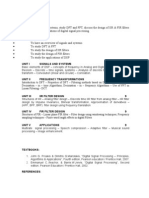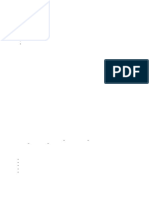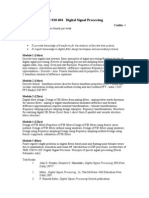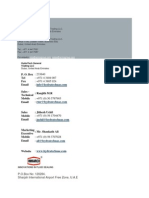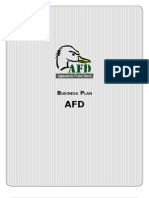0 ratings0% found this document useful (0 votes)
82 viewsDspsyllabus
This document outlines the units of study for a Digital Signal Processing course. The 8 units cover topics such as: discrete time signals and linear systems; discrete Fourier series and transforms; fast Fourier transforms; realization of digital filters including IIR and FIR filters; multi-rate digital signal processing; and applications of DSP like spectral analysis and signal compression. Design techniques are presented for IIR filters using analog prototypes and FIR filters using windowing methods. Reference books are also listed.
Uploaded by
Ashok KumarCopyright
© © All Rights Reserved
Available Formats
Download as DOCX, PDF, TXT or read online on Scribd
0 ratings0% found this document useful (0 votes)
82 viewsDspsyllabus
This document outlines the units of study for a Digital Signal Processing course. The 8 units cover topics such as: discrete time signals and linear systems; discrete Fourier series and transforms; fast Fourier transforms; realization of digital filters including IIR and FIR filters; multi-rate digital signal processing; and applications of DSP like spectral analysis and signal compression. Design techniques are presented for IIR filters using analog prototypes and FIR filters using windowing methods. Reference books are also listed.
Uploaded by
Ashok KumarCopyright
© © All Rights Reserved
Available Formats
Download as DOCX, PDF, TXT or read online on Scribd
You are on page 1/ 1
JAWAHARLAL NEHRU
TECHNOLOGICAL UNIVERSITY ANANTAPUR
Electronics and Communication Engineering
(9A04603) DIGITAL SIGNAL PROCESSING
(Common to ECE, E Con E, EIE, ECM)
B.Tech III-II Sem. (E.C.E.)
UNIT-I
INTRODUCTION
Introduction to digital signal processing: Discrete time signals and sequences, linear shift invariant
systems, stability and causality, linear constant coefficient difference equations. Frequency domain
representation of discrete time signals and systems.
UNIT-II
DISCRETE FOURIER SERIES
Properties of discrete Fourier series, DFS representation of periodic sequences, discrete Fourier
transforms: properties of DFT, linear convolution of sequences using DFT, computation of DFT.
Relation between Z-Transform and DFS.
UNIT-III
FAST FOURIER TRANSFORMS
Fast Fourier transforms (FFT)-Radix2 decimation in time and decimation in frequency FFT
algorithms, inverse FFT and FFT for composite N.
UNIT-IV
REALIZATION OF DIGITAL FILTERS
Review of Z-transforms, applications of Z-Transforms, solution of difference equations of digital
filters, block diagram representation of linear constant-coefficient difference equations, basic
structures of IIR systems, transposed forms, basic structures of FIR systems, system function.
UNIT-V
IIR DIGITAL FILTERS
Analog filter approximations-Butterworth and chebyshev, design of IIR digital filters from analog
filters, design examples: analog-digital transformations, Illustrative Problems.
UNIT-VI
FIR DIGITAL FILTERS
Characteristics of FIR digital filters, frequency response. Design of FIR digital filters using window
techniques, frequency sampling technique, comparison of IIR and FIR filters, Illustrative Problems.
UNIT-VII
MULTIRATE DIGITAL SIGNAL PROCESSING FUNDAMENTALS:
Basic sample rate alteration devices, Multirate Structures for sampling rate Converters, Multistage
design of decimator and Interpolator, Polyphase Decomposition, Nyquist filters.
UNIT-VIII
APPLICATIONS OF DIGITAL SIGNAL PROCESSING:
Spectral analysis of nonstationary Signals, Musical Sound processing, signal Compression,
Transmultiplexers, Discrete Multitone Transmission of digital data.
TEXT BOOKS:
1. Digital signal processing, principles, Algorithms and applications: John G. Proakis, Dimitris G.
Manolakis, Pearson Education/PHI, 4th ed., 2007.
2. Digital signal processing , A computer base approach- Sanjit K Mitra, Tata Mcgraw Hill, 3 rd
edition, 2009.
3. Discrete Time Signal Processing-A.V. Oppenheim and R.W. Schaffer, 2nd ed., PHI.
REFERENCES:
1. Digital signal processing: Andreas Antoniou, TATA McGraw Hill, 2006.
2. A Text book on Digital Signal processing R S Kaler, M Kulkarni,, Umesh Gupta, I K
International Publisthing House Pvt. Ltd.
3. Digital signal processing: M H Hayes, Schaums outlines, TATA Mc-Graw Hill, 2007.
You might also like
- Escheme Networkservice - Citroen.com Imprimer100% (3)Escheme Networkservice - Citroen.com Imprimer3 pages
- CS2403 Digital Signal Processing L T P C 3 0 0 3: Unit I Signals and Systems 9No ratings yetCS2403 Digital Signal Processing L T P C 3 0 0 3: Unit I Signals and Systems 91 page
- Krishna Murthy Institute of Technology and EngineeringNo ratings yetKrishna Murthy Institute of Technology and Engineering2 pages
- Ee8591 Digital Signal Processing Unit I IntroductionNo ratings yetEe8591 Digital Signal Processing Unit I Introduction2 pages
- Rajalakshmi Engineering College: Thandalam, Chennai - 602 105 Lesson PlanNo ratings yetRajalakshmi Engineering College: Thandalam, Chennai - 602 105 Lesson Plan6 pages
- Aim and Objective of The Course:: Course Structure Analysis Subject WiseNo ratings yetAim and Objective of The Course:: Course Structure Analysis Subject Wise10 pages
- Ee8591 Digital Signal Processing L T P C 2 2 0 3No ratings yetEe8591 Digital Signal Processing L T P C 2 2 0 33 pages
- TEACHING PLAN: 12EI301 Advanced Digital Signal Processing (Credits 3: 1:0) July 2013 To Nov 2013No ratings yetTEACHING PLAN: 12EI301 Advanced Digital Signal Processing (Credits 3: 1:0) July 2013 To Nov 20132 pages
- Digital Signal Processing (8SRN4/7IT01) : Unit Wise Course ContentsNo ratings yetDigital Signal Processing (8SRN4/7IT01) : Unit Wise Course Contents3 pages
- Objectives:: at The End of The Course, The Student Should Be Able ToNo ratings yetObjectives:: at The End of The Course, The Student Should Be Able To2 pages
- Digital Signal Processing: Course Code: 15EC1115 L T P C 3 1 0 4No ratings yetDigital Signal Processing: Course Code: 15EC1115 L T P C 3 1 0 43 pages
- Class: Iii Year - It Subject: Digital Signal Processing: A) Text Books: (TX)No ratings yetClass: Iii Year - It Subject: Digital Signal Processing: A) Text Books: (TX)4 pages
- Digital Signal Processing EC-602 Contracts: 3L Credits - 3: Module - INo ratings yetDigital Signal Processing EC-602 Contracts: 3L Credits - 3: Module - I1 page
- Eurec602: Digital Signal Processing Unit I: B.Tech. (Ece) - Vi SemesterNo ratings yetEurec602: Digital Signal Processing Unit I: B.Tech. (Ece) - Vi Semester2 pages
- Cs2403 Digital Signal Processing L T P C 3 0 0 3No ratings yetCs2403 Digital Signal Processing L T P C 3 0 0 31 page
- Introduction To Digital Signal Processing: Course Code:13EE1116 L TPC 4 1 0 3No ratings yetIntroduction To Digital Signal Processing: Course Code:13EE1116 L TPC 4 1 0 33 pages
- Discrete Time Signal Processing SyllabusNo ratings yetDiscrete Time Signal Processing Syllabus2 pages
- RF Analog Impairments Modeling for Communication Systems Simulation: Application to OFDM-based TransceiversFrom EverandRF Analog Impairments Modeling for Communication Systems Simulation: Application to OFDM-based TransceiversNo ratings yet
- Digital Signal Processing for Audio Applications: Volume 1 - FormulaeFrom EverandDigital Signal Processing for Audio Applications: Volume 1 - FormulaeNo ratings yet
- C Ti P Ti Coating Practices: International Association of Oil & Gas Producers Coatings Workshop June 10, 2008No ratings yetC Ti P Ti Coating Practices: International Association of Oil & Gas Producers Coatings Workshop June 10, 200828 pages
- Onward Journey Ticket Details: ConfirmedNo ratings yetOnward Journey Ticket Details: Confirmed2 pages
- Revision Notes For Exam 2011 Computer Science75% (4)Revision Notes For Exam 2011 Computer Science52 pages
- Bekic - Brodolomi Na Rtu Uljeva Kod Ližnjana 2013 - SH3No ratings yetBekic - Brodolomi Na Rtu Uljeva Kod Ližnjana 2013 - SH35 pages
- Catalog Number: HTFX330125 Product ID: UPC Number: Status:: North American Specifications (UNSPSC)No ratings yetCatalog Number: HTFX330125 Product ID: UPC Number: Status:: North American Specifications (UNSPSC)1 page
- Advanced Novell Network Management Netware 6No ratings yetAdvanced Novell Network Management Netware 6699 pages
- samsung_sv-a60xk_sv-a61xk_sv-a70xk_sv-a80xk_sv-400x_sv-401x_sv-403x_sv-405x_vcr_smNo ratings yetsamsung_sv-a60xk_sv-a61xk_sv-a70xk_sv-a80xk_sv-400x_sv-401x_sv-403x_sv-405x_vcr_sm77 pages
- Firewater Pump Systems For FPSOs and FSOs BROCHURE100% (1)Firewater Pump Systems For FPSOs and FSOs BROCHURE8 pages
- 2015 Mathematics Grade 4 Unit 3 Study Guide 2No ratings yet2015 Mathematics Grade 4 Unit 3 Study Guide 210 pages


















